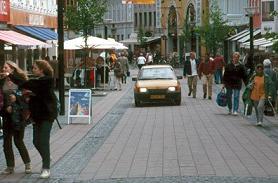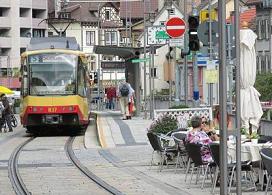Spadina Literary Review — edition 7 page 15
.../
Terhani’s new building is pretty large but he has tried to moderate the impact with the low green-roof pavilions mentioned above. Beyond that, Terhani's pro-pedestrian activism may help to improve the U of T’s local reputation. The iron fence around the site will disappear, to be replaced with a ring of what the architects call “woonerf-style paving.”

København: mixing with autos
Woonerf is a Dutch term meaning something like “living space.” In Europe a woonerf is usually a residential street, and occasionally a commercial street, where pedestrians and cyclists, instead of being marginalized, have priority over motorists. Curbs, marked lanes, and other design elements that encourage drivers to believe the street is made for themselves, are removed. Speed limits are reduced, and other traffic calming measures may include bollards and special pavement treatments.
Being a campus, the U of T has an interest in giving priority to pedestrian movement. The city’s official plan supports this idea. But these woonerven we're talking about are most often set up in neighborhoods or oldtowns. What parts of the concept can be made to work on a big-city artery?

Karlsruhe: mixing with streetcars
The first objection might be the streetcars, including the new extra-long streetcars, snaking round the circle within inches of the woonerf lollygaggers. But there are plenty of European examples of pedestrians and streetcars intermixing at close quarters. It’s a matter of moving at crawl speed and clanging the bell. My understanding is that the U of T is pushing for TTC stops on the island, so the streetcars would be slowing for that anyway.
The situation with respect to auto traffic is more difficult. For both practical and political reasons, there are limits on how much you can disrupt the flow on a major artery. Toronto is nowhere close to even the faintest understanding of the need for a social reconstruction of the street. Still, pedestrians should be enabled to get across without getting skewered by some jerk peeling round like he’s doing Le Mans. Speeds simply will have to drop, or rather be forced to drop.
A basic woonerf concept is to signal to drivers that they have entered a special zone. One way to help the idea sink in is to use special paving, usually bricks. Let drivers feel from the rumble in their tires that they are entering, trespassing upon, a special precinct. Narrow the roadway by a lane in each direction, perhaps by restoring something like the old landscaped boulevard and/or setting up a bike lane, whatever. Get the Daniels students working on it. Could there be a better place than here at the perimeter of an urban design school to make a statement in favor of living space?